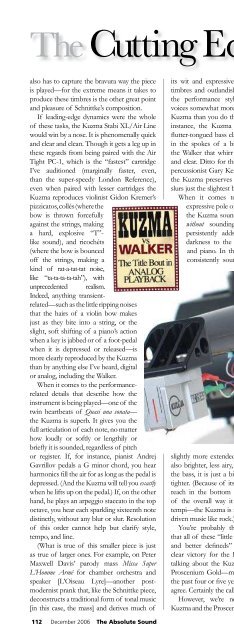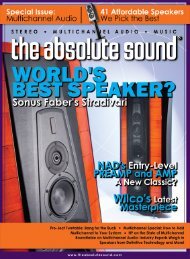Create successful ePaper yourself
Turn your PDF publications into a flip-book with our unique Google optimized e-Paper software.
The Cutting Edge<br />
also has to capture the bravura way the piece<br />
is played—for the extreme means it takes to<br />
produce these timbres is the other great point<br />
and pleasure of Schnittke’s composition.<br />
If leading-edge dynamics were the whole<br />
of these tasks, the Kuzma Stabi XL/Air Line<br />
would win by a nose. It is phenomenally quick<br />
and clear and clean. Though it gets a leg up in<br />
these regards from being paired with the Air<br />
Tight PC-1, which is the “fastest” cartridge<br />
I’ve auditioned (marginally faster, even,<br />
than the super-speedy London Reference),<br />
even when paired with lesser cartridges the<br />
Kuzma reproduces violinist Gidon Kremer’s<br />
pizzicatos, collés (where the<br />
bow is thrown forcefully<br />
against the strings, making<br />
a hard, explosive “T”-<br />
like sound), and ricochéts<br />
(where the bow is bounced<br />
off the strings, making a<br />
kind of rat-a-tat-tat noise,<br />
like “ta-ta-ta-ta-tah”), with<br />
unprecedented realism.<br />
Indeed, anything transientrelated—such<br />
as the little ripping noises<br />
that the hairs of a violin bow makes<br />
just as they bite into a string, or the<br />
slight, soft shifting of a piano’s action<br />
when a key is jabbed or of a foot-pedal<br />
when it is depressed or released—is<br />
more clearly reproduced by the Kuzma<br />
than by anything else I’ve heard, digital<br />
or analog, including the Walker.<br />
When it comes to the performancerelated<br />
details that describe how the<br />
instrument is being played—one of the<br />
twin heartbeats of Quasi una sonata—<br />
the Kuzma is superb. It gives you the<br />
full articulation of each note, no matter<br />
how loudly or softly or lengthily or<br />
briefly it is sounded, regardless of pitch<br />
or register. If, for instance, pianist Andrej<br />
Gavrillov pedals a G minor chord, you hear<br />
harmonics fill the air for as long as the pedal is<br />
depressed. (And the Kuzma will tell you exactly<br />
when he lifts up on the pedal.) If, on the other<br />
hand, he plays an arpeggio staccato in the top<br />
octave, you hear each sparkling sixteenth note<br />
distinctly, without any blur or slur. Resolution<br />
of this order cannot help but clarify style,<br />
tempo, and line.<br />
(What is true of this smaller piece is just<br />
as true of larger ones. For example, on Peter<br />
Maxwell Davis’ parody mass Missa Super<br />
L’Homme Armé for chamber orchestra and<br />
speaker [L’Oiseau Lyre]—another postmodernist<br />
prank that, like the Schnittke piece,<br />
deconstructs a traditional form of tonal music<br />
[in this case, the mass] and derives much of<br />
112 December 2006 The Absolute Sound<br />
its wit and expressiveness from its unusual<br />
timbres and outlandish dynamics—you hear<br />
the performance style, tempo, and inner<br />
voices somewhat more distinctly through the<br />
Kuzma than you do through the Walker. For<br />
instance, the Kuzma makes Alan Hacker’s<br />
flutter-tongued bass clarinet whirr like a card<br />
in the spokes of a bicycle wheel. Through<br />
the Walker that whirr is just a bit less crisp<br />
and clear. Ditto for the individual strokes of<br />
percussionist Gary Kettel’s drum rolls, which<br />
the Kuzma preserves intact and the Walker<br />
slurs just the slightest bit.)<br />
When it comes to timbres—the other<br />
expressive pole of the Schnittke piece—<br />
the Kuzma sounds just plain gorgeous,<br />
without sounding just plain real. It<br />
persistently adds a slight voluptuous<br />
darkness to the timbres of the violin<br />
and piano. In the treble, the Stabi XL<br />
consistently sounds a bit quicker and<br />
slightly more extended than the Walker, but<br />
also brighter, less airy, and more forward. In<br />
the bass, it is just a bit “faster,” leaner, and<br />
tighter. (Because of its speed, definition, and<br />
reach in the bottom octaves—and because<br />
of the overall way it clarifies rhythms and<br />
tempi—the Kuzma is simply a killer on beatdriven<br />
music like rock.)<br />
You’re probably thinking, at this point,<br />
that all of these “little bit fasters and clearers<br />
and better defineds” should add up to a<br />
clear victory for the Kuzma. And were we<br />
talking about the Kuzma versus the Walker<br />
Proscenium Gold—my analog reference for<br />
the past four or five years—I’d be tempted to<br />
agree. Certainly the call would be very close.<br />
However, we’re not talking about the<br />
Kuzma and the Proscenium Gold; we’re talking<br />
about the Kuzma and the Proscenium Black<br />
Diamond. And to me, the call, though a bit of<br />
a split decision, isn’t finally all that close.<br />
Here’s the difference between the Kuzma<br />
Stabi XL/Air Line and the Walker Proscenium<br />
Black Diamond on Quasi una sonata (and<br />
everything else): The Kuzma reproduces the<br />
violin and piano on the Schnittke piece like<br />
the best possible hi-fi—everything you could<br />
possibly want to know about how they are being<br />
played is there for the hearing. All the Walker<br />
does, by comparison, is make that violin and<br />
piano sound a bit less like superb reproductions<br />
and a bit more like real instruments playing in<br />
your room. That’s all.<br />
Returning to Quasi una sonata, the very first<br />
thing you notice when you switch from one<br />
’table to the other isn’t what’s gone missing<br />
with the Kuzma but what’s been added by the<br />
Walker. The change isn’t subtle—not something<br />
you need “golden ears” to hear. It’s as if some<br />
of the air from the Walker’s massive airsupply<br />
box has been piped directly into<br />
the soundstage. The space between the<br />
violin and the piano—and the sense of<br />
space around both instruments—grows<br />
much larger; the stage “walls” seem to<br />
move considerably farther back and<br />
farther apart; and the instruments<br />
themselves sound bigger, as if some<br />
of that same air has been pumped into<br />
them, blowing them up and filling them<br />
out more fully in three dimensions. As<br />
a result, you suddenly realize that this is<br />
a live recording, made in front of a real<br />
audience in a real space. You also realize<br />
that part of what makes Quasi una sonata<br />
work is the way that the violin and piano<br />
bisect that space—each owning (and<br />
holding) its own ground in this contest<br />
of musical wills.<br />
Then there are the changes in the<br />
timbres and dynamics of the instruments.<br />
The Kuzma’s slight overall darkness vanishes,<br />
replaced by a neutrality that simply sounds<br />
“right.” No, the violin’s pizzicatos and collés<br />
aren’t quite as fast as they are on the Kuzma<br />
(though still plenty fast), but its fundamentals<br />
and overtones are considerably more realistic;<br />
no, the piano doesn’t have quite the articulation<br />
of the Kuzma in those top-octave runs, but it<br />
has more of the color, authority, and solidity<br />
of an actual grand piano from bottom to top.<br />
That hard-to-find but essential quality that I<br />
call “action”—the way instruments change<br />
their size, shape, and projection with changes<br />
in register and intensity, making them seem to<br />
“bloom” out towards you and recede back away<br />
from you as the pulse of the music rises and<br />
falls—is much more clearly in evidence. Indeed,










